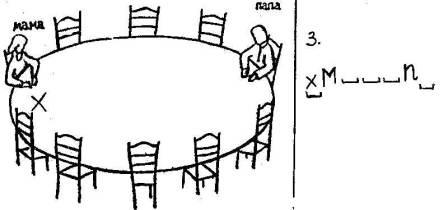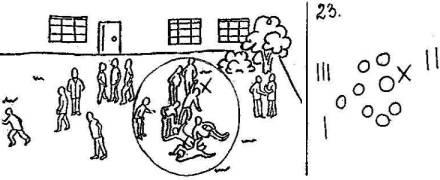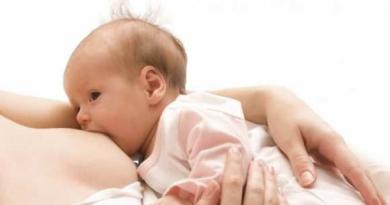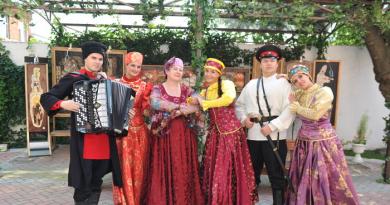To study the sphere of interpersonal relationships of the child and his perception within family relations intended for children projective technique Rene Gilles. The purpose of the technique is to study the child’s social adjustment, as well as his relationships with others.
The technique is visual-verbal, consists of 42 pictures depicting children or children and adults, as well as text tasks. Its focus is to identify behavioral characteristics in a variety of life situations, important for the child and affecting his relationships with other people.
Before starting to work with the technique, the child is informed that he is expected to answer questions based on the pictures. The child looks at the drawings, listens or reads the questions and answers. The child must choose a place for himself among the people depicted, or identify himself with a character occupying one or another place in the group. He can choose it closer or further from a certain person. In text tasks, the child is asked to choose a typical form of behavior. Thus, the technique allows you to obtain information about the child’s attitude towards various people around him (the family environment) and phenomena.
The simplicity and schematic nature that distinguishes R. Gilles’ method from other projective tests not only makes it easier for the child being tested, but also makes it possible to formalize it relatively more. In addition to the qualitative assessment of results, the children's projective method of interpersonal relationships allows one to present the results of a psychological examination on a number of variables and quantitatively.
The technique can be used when examining children from 4 to 12 years, and in case of pronounced infantilism and delay mental development- and older age.
Psychological material characterizing the child’s system of personal relationships, obtained using the technique, can be divided into two large groups of variables:
1. Variables characterizing the child’s specific personal relationships with other people:
- attitude towards mother;
- attitude towards father;
- attitude towards mother and father, perceived by the child as a parental couple (parents);
- attitude towards brothers and sisters;
- attitude towards grandparents and other close adult relatives;
- attitude towards a friend (girlfriend);
- attitude towards the teacher (educator).
- curiosity;
- desire to communicate in large groups of children;
- desire for dominance and leadership in groups of children;
- conflict, aggressiveness;
- reaction to frustration;
- desire for solitude.
Test material
1. Here is the table they are sitting at different people. Mark with a cross where you will sit.
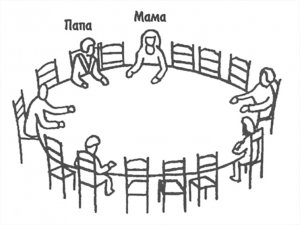
2. Mark with a cross where you will sit.
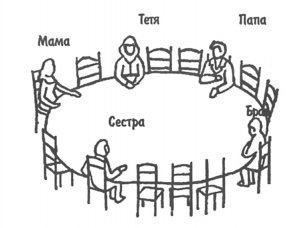
3. Mark with a cross where you will sit.
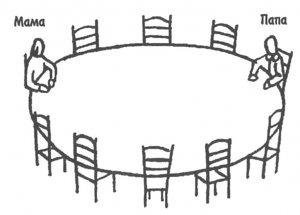
4. Now place several people and yourself around this table. Indicate their family relationships (father, mother, brother, sister) or (friend, comrade, classmate).
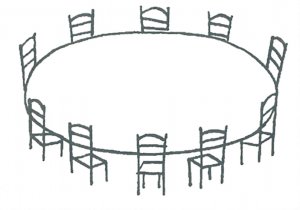
5. Here is a table, at the head of which sits a person whom you know well. Where would you sit? Who is this man?
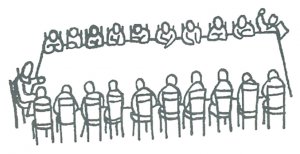
6. You and your family will spend your holidays with your owners who have a big house. Your family has already occupied several rooms. Choose a room for yourself.
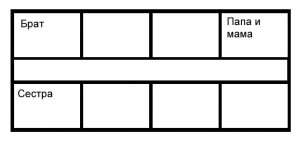
7. You have been staying with friends for a long time. Mark with a cross the room that you would choose (choose).
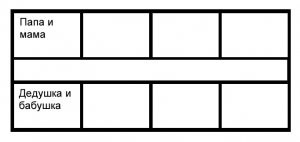
8. Once again with friends. Label some people's rooms and your room.
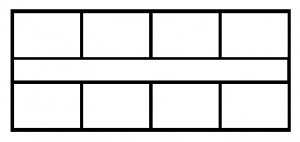
9. It was decided to give one person a surprise. Do you want this done? To whom? Or maybe you don't care? Write below.
10. You have the opportunity to go on vacation for several days, but where you are going there are only two free places: one for you, the second for another person. Who would you take with you? Write below.
11. You have lost something that is very expensive. Who will you tell first about this trouble? Write below.
12. Your teeth hurt and you must go to the dentist to have the bad tooth pulled out. Will you go alone? Or with someone? If you go with someone, who is that person? Write.
13. You passed the exam. Who will you tell about this first? Write below.
14. You are on a walk outside the city. Mark with a cross where you are.
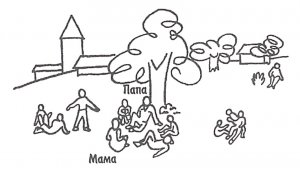
15. Another walk. Mark where you are this time.
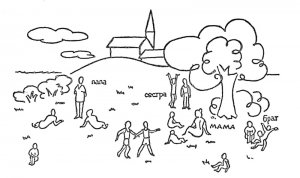
16. Where are you this time?
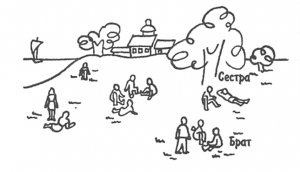
17. Now place several people and yourself in this picture. Draw or mark with crosses. Write down what kind of people they are.
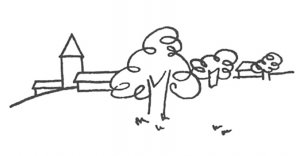
18. You and some others were given gifts. Someone received a gift much better than others. Who would you like to see in his place? Or maybe you don't care? Write.
19. You are going on a long journey, traveling far from your family. Who would you miss the most? Write below.
20. Your friends are going for a walk. Mark with a cross where you are.
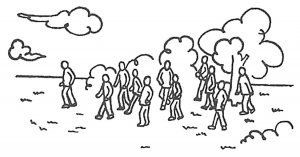
21. Who do you like to play with: friends your age; younger than you; older than you? Underline one of the possible answers.
22. This is a playground. Mark where you are.
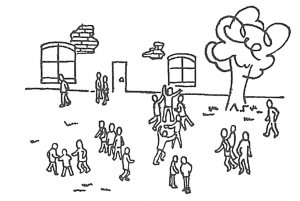
23. Here are your comrades. They are fighting for a reason unknown to you. Mark with a cross where you will be.
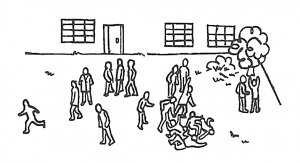
24. These are your comrades quarreling over the rules of the game. Mark where you are.
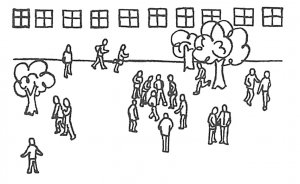
25. A friend deliberately pushed you and knocked you down. What will you do: you will cry; complain to the teacher; hit him; reprimand him; won't you say anything? Underline one of the answers.
26. Here is a man well known to you. He says something to those sitting on the chairs. You are among them. Mark with a cross where you are.
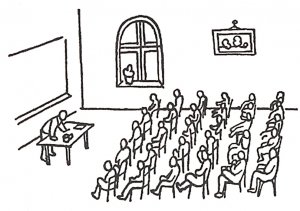
27. Do you help your mother a lot? Few? Rarely? Underline one of the answers.
28. These people are standing around the table, and one of them is explaining something. You are among those who listen. Mark where you are.
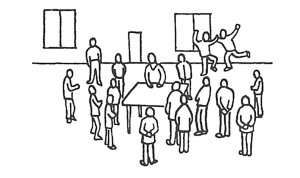
29. You and your friends are on a walk, one woman explains something to you. Mark with a cross where you are.
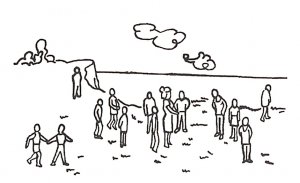
30. During the walk, everyone sat down on the grass. Mark where you are.
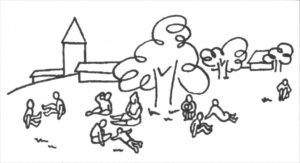
31. These are people who are watching an interesting performance. Mark with a cross where you are.
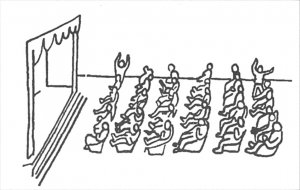
32. This is a table display. Mark with a cross where you are.
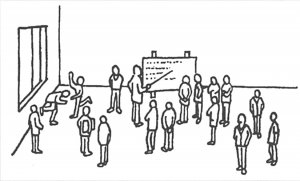
33. One of your comrades laughs at you. What will you do: you will cry; shrug your shoulders; you yourself will laugh at him; Are you going to call him names and beat him? Underline one of these answers.
34. One of your comrades laughs at your friend. What will you do: you will cry; shrug your shoulders; you yourself will laugh at him; Are you going to call him names and beat him? Underline one of these answers.
35. A friend took your pen without permission. What will you do: cry; complain; scream; try to take it away; will you start beating him? Underline one of these answers.
36. You play lotto (or checkers, or another game) and lose twice in a row. Are you unhappy? What will you do: cry; continue playing; you can't say anything; will you start to get angry? Underline one of these answers.
37. Father doesn’t allow you to go for a walk. What will you do: you won’t answer anything; pout; you start crying; protest; will you try to go against the ban? Underline one of these answers.
38. Mom doesn’t allow you to go for a walk. What will you do: you won’t answer anything; pout; you start crying; protest; will you try to go against the ban? Underline one of these answers.
39. The teacher came out and entrusted you with supervision of the class. Are you able to complete this assignment? Write below.
40. You went to the cinema with your family. There are many empty seats in the cinema. Where will you sit? Where will those who came with you sit?
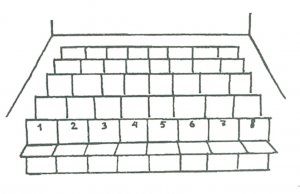
41. There are many empty seats in the cinema. Your relatives have already taken their places. Mark with a cross where you will sit.
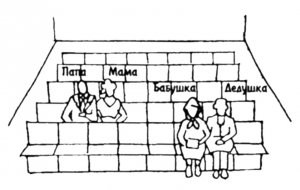
42. At the cinema again. Where will you sit?
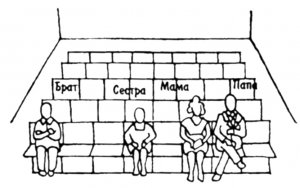
Key to the test
Each of the 13 variables forms an independent scale. The table, which presents all the scales, also indicates the number of tasks of the method related to one or another scale (for example, in scale No. 1 - “attitude towards the mother” - there are 20 of them) and the numbers of these tasks.
| Scale name | Job numbers | Number of tasks |
|---|---|---|
| Attitude towards mother | 1-4, 8-15, 17-19, 27, 38, 40-42 | 20 |
| Relationship to father | 1-5, 8-15, 17-19, 37, 40-42 | 20 |
| Attitude towards mother and father together, perceived by the child as a parental couple (“parents”) | 1, 3, 4, 6-8, 13-14, 17, 40-42 | 12 |
| Relationship to brothers and sisters | 2, 4-6, 8-13, 15-19, 30, 40, 42 | 18 |
| Relationship to grandparents and other close relatives | 2, 4, 5, 7-13, 17-19, 30, 40, 41 | 16 |
| Attitude towards a friend | 4, 5, 8-13, 17-19, 30, 34, 40 | 14 |
| Attitude towards the teacher, educator | 5, 9, 11, 13, 17, 18, 26, 28-30, 32, 40 | 12 |
| Curiosity | 5, 26, 28, 29, 31, 32 | 6 |
| The desire to communicate in large groups of children (“sociability in a group of children”) | 4, 8, 17, 20, 22-24, 40 | 8 |
| The desire for dominance or leadership in a group of children | 20-24, 39 | 6 |
| Conflict, aggressiveness | 22-25, 33-35, 37, 38 | 9 |
| Reaction to frustration | 25, 33-38 | 7 |
| Desire for solitude, isolation | 7-10, 14-19, 21, 22, 24, 30, 40-42 | 18 |
One of the types of decoration is creating a bas-relief. Bas-relief is three-dimensional images on the walls. Flowers, images of animals and various patterns can serve as bas-relief designs.
Applying a bas-relief image to walls and ceilings requires the ability to apply drawings on surfaces, followed by the application of volumetric modeling on them.
To create a three-dimensional pattern, the first thing you need to do is level the wall. For this purpose, sheets of drywall need to be laid over the entire area that has an uneven surface. In this case, a profile frame is made on which the sheets will be installed. Thus, using a frame and drywall, a flat wall is created.
Hobby. What is it?
No one knows us better than we know ourselves. At first glance, a confusing expression. But if you read it carefully, then what is written is really true. Only we ourselves can give a specific and clear answer to the question: who we are in this life and what we want to achieve or achieve. People around us often evaluate our actions, words, behavior, etc. However, they cannot sign for our tastes, interests, and preferences. Consequently, we determine for ourselves what we want to do in life and what interests us. Throughout many years Human hobbies are called in one word - hobbies. This article will answer the following questions: What is a hobby? What types does it come in? What are the benefits of a hobby?
Rene Gilles technique
Scales: attitude towards mother, attitude towards father, attitude towards parents, attitude towards brothers and sisters, attitude towards close relatives, attitude towards a friend, attitude towards a teacher, curiosity, sociability, desire for leadership, aggressiveness, reaction to frustration, desire for solitude
Purpose of the test
A study of the child’s social adaptability, the scope of his interpersonal relationships and their characteristics, his perception of intrafamily relationships, and some characteristics of his behavior.
The technique allows us to identify conflict zones in the child’s system of interpersonal relationships, thereby making it possible, by influencing these relationships, to influence the further development of the child’s personality.
Test Description
Projective visual-verbal technique R. Gilles consists of 42 tasks, including 25 pictures depicting children or children and adults, a short text explaining the depicted situation and a question for the subject, as well as 17 text tasks.
The child, looking at the drawings, answers the questions posed to them, shows the place he has chosen for himself in the picture depicted, tells how he would behave in a given situation, or chooses one of the listed behavior options.
The experimenter can be recommended to accompany the examination with a conversation with the child, during which one can clarify one or another answer, find out the details of the child’s choices, find out, perhaps, some special, “touchy” moments in his life, learn about the real composition of the family , and also ask who are the people who are drawn but not indicated in the pictures (for example, picture No. 1, it is important to write down the order in which they are named). In general, you can use the opportunities that projective techniques provide.
The technique can be used when examining children from 4 to 12 years, and in the case of pronounced infantilism and mental retardation - even at an older age.
Psychological material characterizing the child’s system of personal relationships, obtained using the technique, can be divided into two large groups of variables:
Variables characterizing specific personal relationships of the child with other people:
attitude towards mother;
attitude towards father;
attitude towards mother and father, perceived by the child as a parental couple (parents);
attitude towards brothers and sisters;
attitude towards grandparents and other close adult relatives;
attitude towards a friend (girlfriend);
attitude towards the teacher (educator).
Variables characterizing characteristics of the child himself:
curiosity;
desire to communicate in large groups of children;
desire for dominance and leadership in groups of children;
conflict, aggressiveness;
reaction to frustration;
desire for solitude
And, as a general conclusion, degree of social adequacy of the child’s behavior, as well as factors (psychological and social) that violate this adequacy.
Test material
Here is a table with different people sitting at it. Mark with a cross where you will sit.
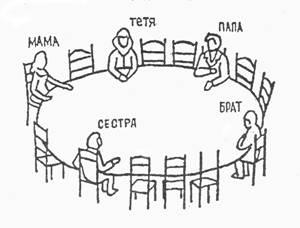
Mark with a cross where you will sit.
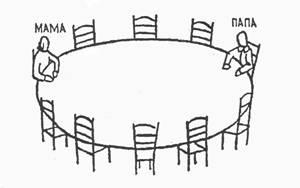
Now place several people and yourself around this table. Indicate their family relationships (father, mother, brother, sister) or (friend, comrade, classmate).
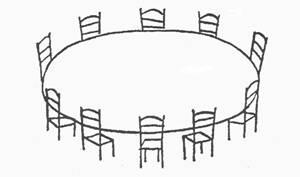
Here is a table at the head of which sits a man whom you know well. Where would you sit? Who is this man?
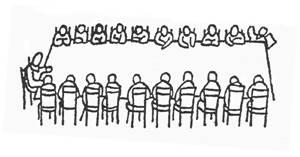
You and your family will spend your holidays with your owners, who have a large house. Your family has already occupied several rooms. Choose a room for yourself.
8. Once again with friends. Label some people's rooms and your room.
9. It was decided to give one person a surprise. Do you want this done? To whom? Or maybe you don't care? Write below.
10. You have the opportunity to go on vacation for several days, but where you are going there are only two free places: one for you, the second for another person. Who would you take with you? Write below.
11. You have lost something that is very expensive. Who will you tell first about this trouble? Write below.
12. Your teeth hurt and you must go to the dentist to have the bad tooth pulled out. Will you go alone? Or with someone? If you go with someone, who is that person? Write.
13.You passed the exam. Who will you tell about this first? Write below.
14.You are on a walk outside the city. Mark with a cross where you are.
![]()
15. Another walk. Mark where you are this time.
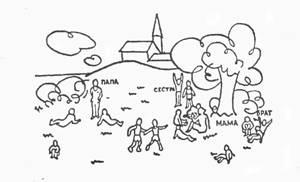
16. Where are you this time? Show or mark with a cross.
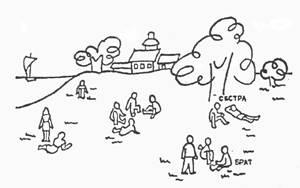
17.Now place several people and yourself in this picture. Draw or mark with crosses. Write down what kind of people they are.
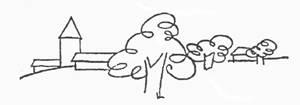
18. You and some others were given gifts. Someone received a gift much better than others. Who would you like to see in his place? Or maybe you don't care? Write.
19. You are going on a long journey, traveling far from your family. Who would you miss the most? Write below.
20. Your friends are going for a walk. Mark with a cross where you are.
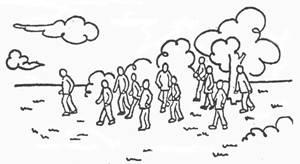
21. Who do you like to play with? With friends your age, younger than you, older than you? Underline one of the possible answers.
22. This is a playground. Mark where you are.
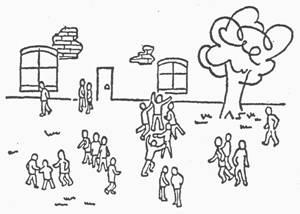
23. Here are your comrades. They are fighting for a reason unknown to you. Mark with a cross where you will be.
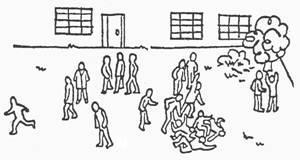
24. These are your comrades quarreling over the rules of the game. Mark where you are.
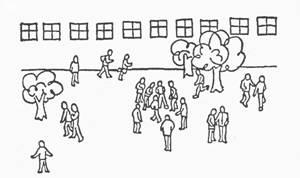
25. A friend deliberately pushed you and knocked you down. What will you do: will you cry? Will you complain to the teacher? Will you hit him? Will you reprimand him? Won't you say anything? Underline one of the answers.
26. Here is a man well known to you. He says something to those sitting on the chairs. You are among them. Mark with a cross where you are.
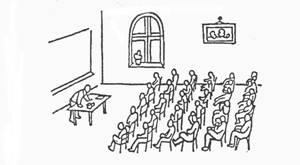
27. Do you help your mother a lot? Few? Rarely? Underline one of the answers.
28. These people are standing around the table, and one of them is explaining something. You are among those who listen. Mark where you are.
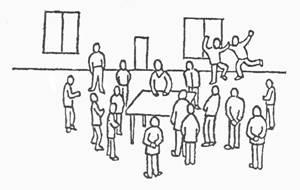
29.You and your friends are on a walk, one woman explains something to you. Mark with a cross where you are.
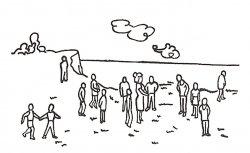
30. During the walk, everyone sat down on the grass. Mark where you are.
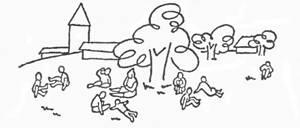
31. These are people who are watching an interesting performance. Mark with a cross where you are.
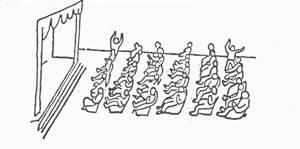
32. This is a table display. Mark with a cross where you are.
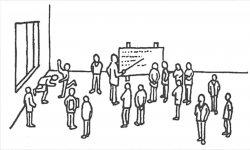
33. One of your comrades laughs at you. What will you do? Are you going to cry? Will you shrug? Will you laugh at him yourself? Are you going to call him names and beat him? Underline one of the answers.
34. One of your comrades laughs at your friend. What will you do? Are you going to cry? Will you shrug? Will you laugh at him yourself? Are you going to call him names and beat him? Underline one of the answers.
35. Did your friend take your pen without permission? What will you do? Are you going to cry? Complain? Scream? Will you try to take it away? Are you going to start beating him? Underline one of these answers.
36. You play lotto (or checkers, or another game), and lose twice in a row. Are you unhappy? What will you do? Cry? Continue playing? Don't you say anything? Are you starting to get angry? Underline one of these answers.
37. Father doesn’t allow you to go for a walk. What will you do: won’t you answer? Are you pouting? Are you going to start crying? Will you protest? Will you try to go against the ban? Underline one of these answers.
38. Mom doesn’t allow you to go for a walk. What will you do: No answer? Are you pouting? Are you going to start crying? Will you protest? Will you try to go against the ban? Underline one of these answers.
39. The teacher came out and entrusted you with supervision of the class. Are you able to complete this assignment? Write below.
40. You went to the cinema with your family; there are many empty seats in the cinema. Where will you sit? Where will those who came with you sit?
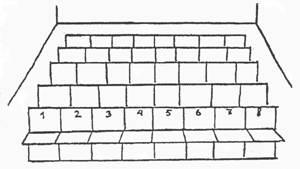
41. There are many empty seats in the cinema. Your relatives have already taken their places. Mark with a cross where you will sit.
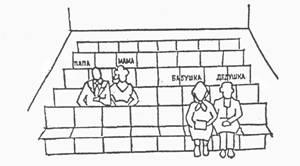
42. At the cinema again. Where will you sit?
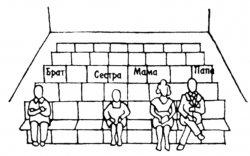
Registration sheet for the method of R. Gilles.
|
Attitude. Behavioral characteristics |
Values in natural units |
Interest |
Normal limits |
Normal limits |
|||||||||||
|
In natural units |
Percentage |
||||||||||||||
|
III. Parental couple | |||||||||||||||
|
IV. Brother, sister | |||||||||||||||
|
V. Grandmother, grandfather, etc. | |||||||||||||||
|
VI. Friend, girlfriend | |||||||||||||||
|
VII. Teacher | |||||||||||||||
|
VIII. Curiosity | |||||||||||||||
|
IX. Sociability in a group | |||||||||||||||
|
X. Dominance, leadership | |||||||||||||||
|
XI. Conflict, aggressiveness | |||||||||||||||
|
XII. Reaction to frustration | |||||||||||||||
|
XIII. Fencing off | |||||||||||||||
The key toThe film is a test of a child's interpersonal relationships. (Rene Gille’s method. / Projective psychodiagnostics) Le Test-Film, Rene’ Gille:
I. Variables characterizing the child’s specific personal relationships with other people:
1) attitude towards the mother;
2) attitude towards the father;
3) attitude towards mother and father in general as parents;
4) attitude towards brothers and sisters;
5) relationships with grandparents;
6) attitude towards a friend;
7) attitude towards the teacher (educator).
II. Variables that characterize the child himself and manifest in his interpersonal relationships:
8) degree of curiosity;
9) the degree of desire to communicate with children in large groups;
10) the degree of desire for dominance and leadership;
11) conflict, aggressiveness;
12) social adequacy of behavior - reaction to frustration;
13) the degree of isolation from others, the desire for solitude.
|
Scale name |
Job No. |
Total number of tasks |
|
|
Attitude towards mother |
1-4,8-15, 17-19, 27, 38, 40-42 | ||
|
Relationship to father |
1-5, 8-15, 17-19, 37, 40-42 | ||
|
Treating mother and father together as a parent couple (parents) |
1, 3, 4, 6-8, 13-14, 17, 40-42 | ||
|
Relationship to brothers and sisters |
2, 4-6, 8-13, 15-19, 30, 40, 42 | ||
|
Relationship to grandparents and other adult relatives |
2, 4, 5, 7-13, 17-19, 30, 40, 41 | ||
|
Attitude towards a friend |
4, 5, 8-13, 17-19, 30, 34, 40 | ||
|
Attitude towards the teacher, educator |
5, 9, 11, 13, 17, 18, 26, 28-30, 32, 40 | ||
|
Curiosity |
5, 26, 28, 29, 31, 32 | ||
|
Desire to communicate in large groups of children |
4, 8, 7, 20, 22-24, 40 | ||
|
The desire for dominance or leadership in a group of children | |||
|
Conflict, aggressiveness |
22-25, 33-35, 37, 38 | ||
|
Reaction to frustration | |||
|
Desire for solitude, isolation |
7-10, 14-19, 21, 22, 24, 30, 40-42 |
|
Job No. |
No. of corresponding scales |
Job No. |
No. of corresponding scales |
|
1, 2, 3, 4, 5, 6, 9 | |||
|
2, 3, 4, 5, 6, 8 | |||
|
1, 2, 3, 4, 5, 6, 9, 13 | |||
|
1, 2, 4, 5, 6, 7, 13 | |||
|
1, 2, 4, 5, 6, 13 | |||
|
1, 2, 4, 5, 6, 7 | |||
|
1, 2, 4, 5, 6, 13 | |||
|
1, 2, 3, 4, 5, 6, 7 | |||
|
1, 2, 3, 4, 5, 6, 7, 9, 13 | |||
|
1, 2, 4, 5, 6, 7, 13 | |||
|
1, 2, 4, 5, 6, 13 |
1, 2, 3, 4, 5, 6, 7, 13 |
||
InterpretationThe film is a test of a child's interpersonal relationships. (Rene Gille’s method. / Projective psychodiagnostics) Le Test-Film, Rene’ Gille:
This technique cannot be classified as purely projective; it is a form transitional between a questionnaire and projective tests. This is its great advantage. It can be used as a tool for in-depth study of personality, as well as in studies requiring measurements and statistical processing. “Film Test” implements the following principles:
principle of "projection"– personal formations, appearing directly or indirectly in the form of various attitudes and behavioral manifestations, are projected into the test situation and do not cause defensive reactions in the test subject;
the principle of “symbolic linearity”– emotional distances between people are expressed through linear distances in a symbolic situation.
A positive emotional attitude is manifested in the choice of a closer distance. During the examination, a detailed story is not required from the subject; it is enough to know his choice in the pictures: who is chosen and in what situations, where and at what distance from certain persons the subject places himself, what behavioral options he prefers in the text tasks offered to him
Note. First, the meaning of the “curiosity” parameter. In everyday consciousness, the concept of “curiosity” is close to the concepts of “inquisitiveness,” “cognitive orientation,” and “cognitive initiative.” In the Gilles test, “curiosity” is operationalized only as “closeness to an adult telling something,” even as “dependence on an adult, knowledge of adults,” “social adequacy of behavior.”
Secondly, the concept of “fencing off”, “desire for solitude”. It turned out that this factor is positively correlated with intelligence! Thus, it is not the “inquisitive” ones - close to the adult telling something, the driven ones - children, but the “solitary” single children in the test pictures who are more intellectually developed and in this sense more independent, aimed not so much at the “human” relationship -person”, how much for the relationship “person-objective world”.
Processing the results (example).
|
Examples of tasks from the “Film Test” by R. Gilles, (a cross indicates the child’s answers) |
Examples of schematic marking of answers in a test book |
Sample answers |
|
3. Show or mark with a cross where you will sit. |
||
|
|
Scale No. 1 – (+) Scale No. 2 – (0) Scale No. 3 – (0) |
|
|
6. You and your family will spend your holidays with friends who have a big house. Your family has already occupied several rooms. Choose a room for yourself. |
||
|
|
Scale No. 3 – (0) Scale No. 4 – (+) |
|
|
23. Here are your comrades. They are fighting for a reason unknown to you. Show or mark with a cross where you will be. Tell me what happened? |
||
|
|
Scale No. 9 – (+) Scale No. 10 – (+) Scale No. 11 – (+) |
|
Results, analysis, conclusion (example).
According to his parents, Sasha entered school at 6.5 years old and at first he was very confident, actively responded in class, and interacted with his peers. A month later, the child’s grades began to decline, cases of stubbornness and even obvious hysterics associated with reluctance to attend school became more frequent. Sasha's parents transferred him to a private school, hoping that an individual approach would change his attitude. The situation smoothed out somewhat, but did not become normal. Currently, Sasha goes to school reluctantly, constantly asking his parents to pick him up earlier. The school is commercial, half board: children stay there from 9 a.m. to 5 p.m. In addition, the boy’s mother is concerned about his worsening night terrors: the child often complains of nightmares and “constantly asks to buy him scary robots and horror films.” Family members have different attitudes toward a child’s fears: mom tries to calm her down, dad doesn’t notice, and older sister calls Sasha a coward.
Family composition: father, 40 years old (engaged in business), mother, 35 years old (teacher at a music school), sister Katya, 11 years old, Sasha, 7.9 years old.
During a psychological study, the boy revealed a high level of intellectual development, as well as pronounced emotional tension (see scales No. 11, 12 of R. Gilles’ method). Aggressive plots and fear plots also appeared in additional projective techniques (for example, in a drawing on a free theme, Sasha depicted a cemetery).
In the results of the examination using the Rene Gilles method, the indicator on the scale of conflict and aggressiveness was higher than normal, and among behavioral reactions (scale No. 12 “Reaction to frustration”) reactions of the active-aggressive type were dominant. Accordingly, the indicator of social adaptation is below the norm. At the same time, there is a clear tendency towards isolation from peers (scale No. 13 “Isolation”). Weak involvement in interaction with peers (underestimated on scale No. 9 “Sociability”) in the presence of a tendency towards dominance and leadership (overestimated on scale No. 10 “Leadership”, No. 11 “Conflict, aggressiveness”) may indicate that the sphere The “child-child” interaction is conflicting for Sasha. The basis of this conflict is probably the contradiction between “I” and “we”, when the child wants, but cannot, enter the reference group of peers, although in fantasies he sees himself as a leader. Thus, the subject has a desire to interact with other children, a desire to establish himself in their eyes, but in reality there is an inability to structure his behavior in accordance with the norms.
Despite the fact that Sasha is socially oriented, inquisitive (scales No. 7, 8), strives to dominate (scale No. 10), the presence of fears reduces his self-confidence, makes his behavior self-protective and aggressive, creates problems in communicating with adults, and deprives him of full communication with peers (according to his mother, Sasha has only two friends - one at school, the other in the yard).
In the sphere of family relations, it should be noted that the boy completely refused contacts with his father against the backdrop of his mother’s preference (the indicator on scale No. 1 is overestimated compared to the normative one). Perhaps Sasha’s strong attachment to her mother causes a reluctance to go to school, as this causes separation from her, which means a loss of self-confidence.
GENERAL CHARACTERISTICS
The Rene Gille test (Le Test-Film, Rene’ Gille) was designed to study personality, to identify the characteristics of the subject’s attitude towards close people (primarily family members), to determine the subject’s reference group. This projective visual-verbal technique was published by R. Gilles in 1959 and was intended for examining children.
The test makes it possible to describe the child’s system of personal relationships. As a result, the researcher receives the following indicators:
Characteristics of the child’s specific personal relationships with other people: mother, father, both parents, brothers and sisters, grandparents, friend, teacher (educator or other adult authoritative for the child);
- characteristics of the child himself: curiosity, desire for dominance in the group, desire to communicate with other children in large groups, isolation from others, desire for solitude, social adequacy of behavior.
All indicators, in addition to qualitative assessment, receive their quantitative expression.
A Russian-language adaptation of R. Gilles’ technique was made in 1976–1978 by I.N. Gilyasheva and N.D. Ignatieva. They used the test to study the child’s social adjustment, the characteristics of his personal relationships with others, some behavioral characteristics and personality traits.
The technique can be used when working with children from 4–5 to 11–12 years old. It is especially effective for subjects who have insufficient speech development, as well as for those who, due to intellectual or emotional disorders, experience difficulties in interpreting ambiguous stimulus material. During the examination, a detailed story is not required from the subject; it is enough for the psychologist to know his choice in the pictures: who is chosen and in what situations, where and at what distance from certain persons the subject places himself, what behavioral options he prefers in the text tasks offered to him.
I.N. Gilyashev and N.D. Ignatiev point out the importance of early examination of the child. In older preschool and primary school age, his personality begins to form and important personal relationships develop for him, primarily in the immediate social environment. Therefore, timely correction of deviations in this area is necessary, since negative interpersonal relationships can adversely affect the child’s adaptation to life. kindergarten and at school, hinder the harmonious formation of his psyche, contribute to the development of neurosis.
The Russian-language adapted version of R. Gilles’ method consists of 42 tasks: these are 25 pictures with a short text and questions addressed to the test subject, as well as 17 text tasks.
FEATURES OF THE CONDUCT
Before starting to work with the technique, the child is informed that he is expected to answer questions based on the pictures.
The content of the pictures varies. Some of them depict a family sitting at a table, in nature, on a walk. Some show a group of children playing something or listening to an adult.
The drawings are quite schematic, unimportant details are omitted, which makes it easier for the subject to identify with a particular character. The latter represent rather a correlation of positions rather than an emotional attitude towards each other.
The child is asked to choose a place among the people depicted or to identify himself with a character occupying one or another place in the group (point to him, mark with a cross in the picture). The authors recommend that after the choice made by the child, supplement the instructions with questions about all the people drawn but not indicated in the pictures (however, this data is taken into account only as additional and is analyzed and interpreted only at a qualitative level), and also write down the order of the named characters.
Text assignments offer a choice of typical forms of behavior in certain situations.
At the end of the study, the psychologist, in a conversation with the child, clarifies all those points that the subject did not report himself. If necessary, the data obtained is supplemented by the results of conversations with parents, teachers, educators, attending physicians, as well as the results of game techniques.
I.N. Gilyashev and N.D. Ignatiev suggests not only qualitatively analyzing the results, but also calculating a quantitative assessment and building a graphic profile of the subject’s interpersonal relationships.
The methodology kit includes:
- methodological manual;
- a set of tasks;
- registration sheet;
- tables of assignment distribution according to scales.
Quantitative results help to obtain additional information for a comparative analysis of experimental psychological data obtained from examining large groups of subjects.
However, in the process of quantitative analysis, “there may be a loss of important psychological information and the original goals of projective testing: identifying those that are inaccessible to a generalized understanding individual characteristics the child, as well as the child’s hidden problems for others” (A.K. Osnitsky).
CHILD'S POSITION AND ADULTS' EXPECTATIONS
A.K. Osnitsky in 1996–1997 expanded the scope of the R. Gilles test. He used the test in individual counseling to detect problems of the child and his loved ones that arise in the process of family interaction. The author notes that this technique best replaces the traditional conversation of the psychologist’s initial acquaintance with the child and contributes to the rapid establishment of contact. He also clarifies the age of the subjects and recommends using this test from 5–6 years of age.
A.K. Osnitsky proposes to carry out family consultation according to the following plan:
When presenting pictures to mom or dad, you need to ask the parents to show “which of the chairs your child would sit on,” “among which guys he would place himself,” etc., to guess the positions that their child could choose. This gives a new, comprehensive picture of parents’ understanding of the child’s relationship with the outside world. Sometimes parents note the possibility of discrepancies between the child’s actual positions and the desired positions. The reasons for these discrepancies have to be determined by a psychologist. Situations when a child builds his positions not in accordance with the expectations of adults are extremely common. Only the degree of this discrepancy differs.
- high (coincidence of 80% and above);
- average (50-79% agreement);
- low (matches in 49% of cases and below).
For the convenience of A.K. Osnitsky developed a response registration form with windows that allows you to see the coincidence/discrepancy of the answers of an adult and a child.
Answer registration form
TO STUDY RELATIONSHIPS
The R. Gilles test, designed to study the relationships of children in the family, and the “Family Drawing” technique can correlate with each other.
We identified the following as the main significant signs of competition between children in a family in the family picture:
- - different sizes of children’s figures;
- the placement of children’s figures is not on the same line;
- isolation of one or both figures of children;
- highlighting the figure of a sibling (brother or sister) or the author with shading and dark tones;
- separation of children's figures by various objects, people or space.
- - the location of children relative to each other (not on the same line);
- separation of children's figures by various objects, people, space;
- the location of children relative to their parents.
For work, only 20 tasks are used from the film test version, widely used in Russian science: 13 pictures and 7 text tasks (their numbers according to the Russian version by I.N. Gilyasheva, N.D. Ignatieva - 1, 2, 4–6, 8–19, 30, 40, 42).
This choice is explained by the correspondence of the items to the “Attitude towards brothers and sisters” scale. The picture tasks were supplemented with phrases like “Who are the other people around you?” (No. 14, 15, etc.) or “Indicate other people sitting at the table” (No. 1). Thus, the picture of interpersonal relationships in the family was more complete.
Experimental work
Experimental work was carried out in a group with children aged 6–14 years. R. Gilles' test was given after the participants completed a family drawing (usually in the next lesson).
This test is most optimally administered with a group of 5–10 children sitting at round table, and the psychologist has the opportunity to observe everyone’s work.
When performing a group test in a class (25–30 people), interpretation questions often arise, and children have the additional opportunity to work in groups.
Individual work It is appropriate for children who cannot read and write, who are slow and have various developmental disabilities.
For ease of processing, we have created a special form for processing the results.
FORM FOR PROCESSING RESULTS
SIGNIFICANT SIGNS
Registration of characteristics is carried out in accordance with the criteria of the “Family Drawing” method. Let us briefly recall them.
Location of children in space
Not registered if there is no piece of one of the siblings. Children can be in one part of the sheet (top or bottom), or in different ( 1 point is given). When the figures are located in one part of the sheet, the sign is counted if the difference in arrangement is visible to the naked eye, i.e. you can tell who is drawn higher and who is lower ( 1 point is given).
Separation of children by objects, people, distance
To register this sign, it is necessary that children do not sit on adjacent chairs (Figures 1, 2, 3, 4, 19, 20), are not in the same room (Figures 5, 6), are not nearby (Figures 12–15, 18 ). Then it is put 1 point.
Location of children relative to parents
Closeness to the parents of one of the children and distance from them of the other emphasizes the exclusive status of one of the siblings and is a sign of competition between them. The author's jealousy of parents is assumed if the sibling is drawn between the parents or close to them.
In the method of R. Gilles 1 point According to this criterion, it is placed when one of the siblings is between the parents, and the other is away from this group, or when one of the children is separated from the parents by the figure of a brother or sister. (In other words, when only one child is in contact with the parents.) In cases where both children are located linearly between the parents or the parents are surrounded by children, it is put 0.5 points.
If all family members are located, as it were, at the corners of a rhombus (square), that is, each child is approximately the same distance from each parent, then 0 points are given.
Similarly, the named signs are noted in the drawings of the family.
In cases where all family members except one of the children are depicted (or named), 2 points are given. A drawing of a family in which one of the children is missing is assessed similarly.
Let's look at an example
As an example, consider the performance of the R. Gilles test by a girl L., seven years old, who has a 1.5-year-old sister.
According to the family drawing, it was recorded: siblings are not located on the same line (1 point); separated by a board (1 point); family members are located as if at the corners of a square (0 points).
A sign of jealousy of L. (a first-grader) towards her younger sister is the desire to “send” the baby to school, as if to change places with her in order to spend more time with her parents. IN in this case In addition to children competing with each other, we can talk about family disunity. Despite the fact that children are on one plane, and parents are on another, neither one nor the other is united into microgroups. Each family member is on their own. The author of the picture treats both parents equally. In her opinion, younger sister closer to mother than to father. Both sisters are approximately the same distance from the mother, so in this case we give 0 points.
1. (1) Here is a table at which different people are sitting. Mark with a cross where you will sit. Who are the other people not shown in the picture?*
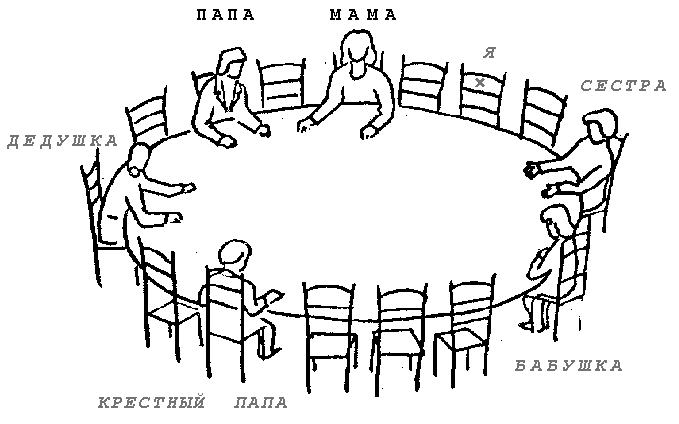
2. (2) Another table. Now where will you sit? Mark with a cross.
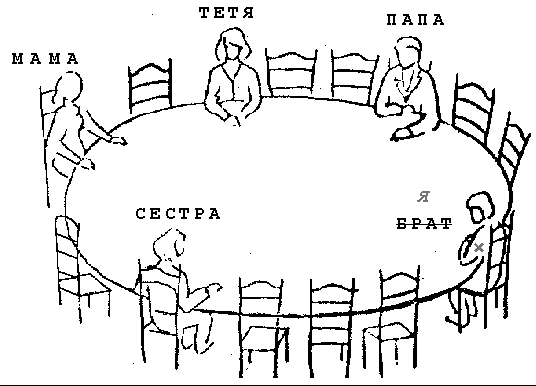
3. (4) Now place several people and yourself around the table. Draw or mark them with crosses.
Write who they are to you (dad, mom, brother, sister or friend, comrade, classmate). Do as you wish.
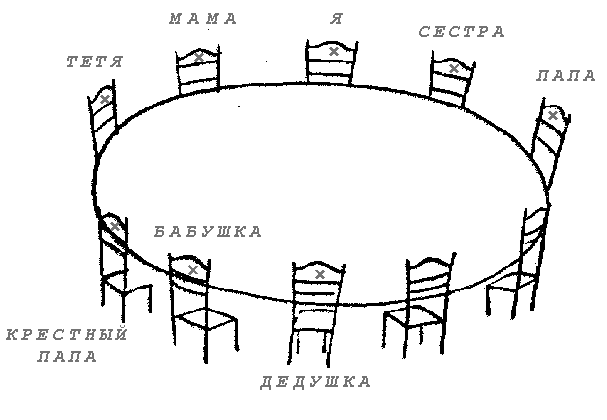
4. (5) Here is the table. At the head of the table sits a man whom you know well. Where would you sit?
Mark with a cross. Who is this man sitting at the head of the table? Write next to it.
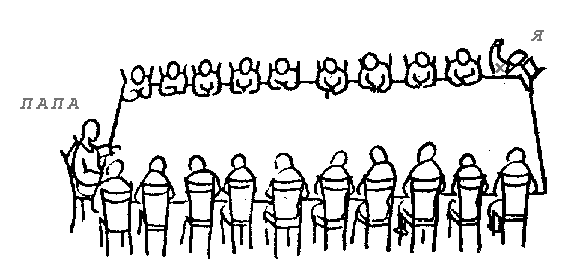
5. (6) Imagine that you and your family will spend your holidays with people who have a big house. Your family members have already occupied several rooms. Choose a room for yourself. Mark it with a cross.
6. (8) Imagine that you are visiting friends. Designate the rooms where your family members are located (choose whoever you want) and your room. Write down who is where.
7. (9) Imagine that you decide to give one person pleasant surprise. Do you want this done? To whom? Or maybe you don't care? Which answer do you choose? Write.
ANSWER: Yes. To my sister
8. (10) Imagine that you have the opportunity to go on vacation for a few days,
but where you are going, there are only two empty seats: one for you, and the second for another person. Who would you take with you? Write.
ANSWER: Sister
9. (10) Imagine that you have lost something that is very expensive. Who will you tell first about this trouble? Write.
ANSWER: Mom
10. (12) Imagine that your teeth hurt and you have to go to the dentist to have the bad tooth pulled out. Will you go alone? Or with someone? Who is this man? Write.
ANSWER: With mom
11. (13) Imagine that you passed the exam (wrote a dictation, test work). Who will you tell about this first? Write.
ANSWER: Mom
12. (14) Imagine that you are on a walk outside the city. Mark with a cross where you are. Next to whom?
![]()
13. (15) Imagine that you are on a different walk. Mark with a cross where you are this time. Next to whom?
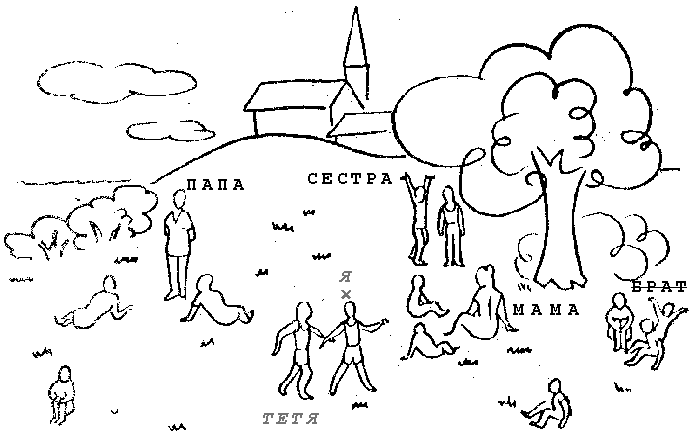
14. (16) Imagine that you are on another walk. Mark with a cross where you are. Next to whom?
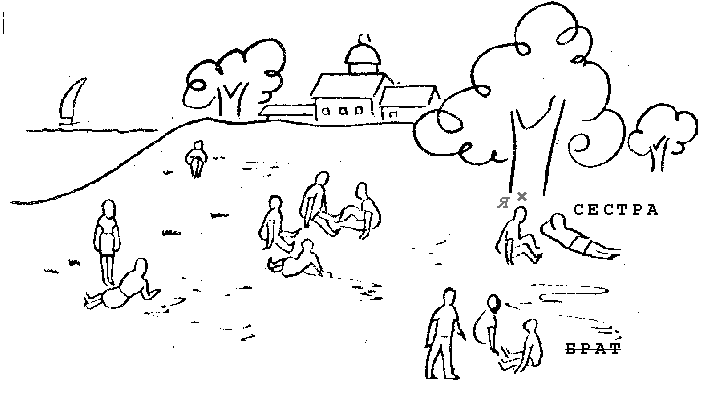
15. (17) Place several people and yourself in this picture. Draw or mark them with crosses. Write down who these people are.
16. (18) Imagine that you and some others were given gifts. Someone received a much better gift than others. Who would you like to see in his place? Or maybe you don't care? Write.
ANSWER: Sister
17. (19) Imagine that you are going on a long journey, traveling far from your family. Who would you miss the most? Write.
ANSWER: By mother
18. (30) Imagine that during a walk everyone sat down on the grass. Mark with a cross where you are. Next to whom?
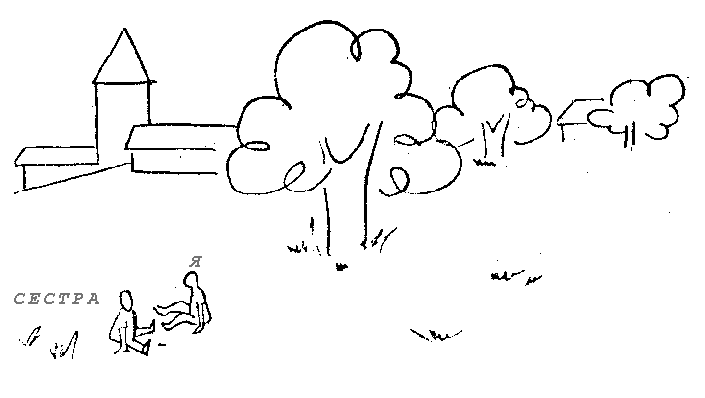
19. (40) Imagine that you went to the cinema with your family. There are many empty seats in the cinema. Where will you sit? Where will those who came with you sit? Write and mark them with a cross.
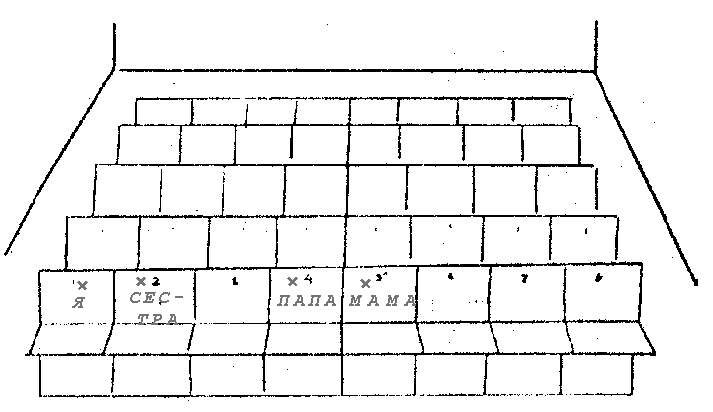
20. (42) Imagine that you are in the cinema again. Your relatives have already taken their places. Mark with a cross where you will sit.
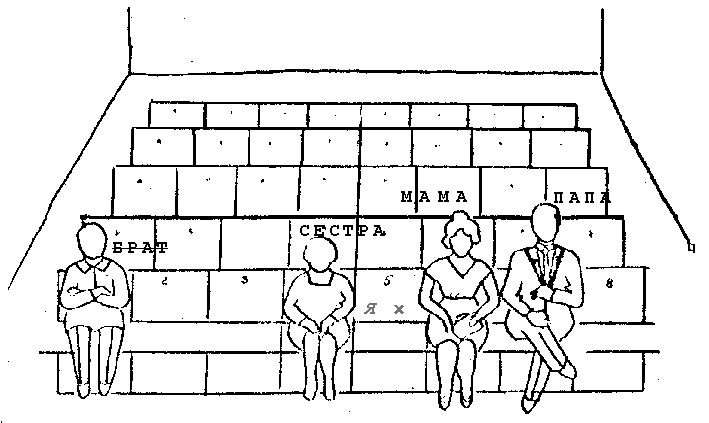
INTERPRETATION
Based on the “disposition of children,” the author receives 1 point for tasks 12, 13 and 0.5 points for tasks 1 and 2. A total of 3 points.
On the basis of “separation of children by objects” - 1 point for tasks 1, 2, 5, 6, 12, 13. Total 6 points.
On the basis of “the location of children relative to their parents” - 2 points for task 18; 1 point for tasks 6, 20; 0.5 points each for tasks 3, 12. Total 5 points.
Thus, the subject’s results for performing the R. Gilles test are 3+6+5=14 points; for completing a family drawing 1+1+0=2 points.
Rene Gilles' method was developed in the late 50s of the last century and allows you to test children from 4 to 12 years old on a variety of indicators. This is an excellent opportunity to explore the child’s social orientation, his attitude towards the family, and even characterize his behavior. In addition, Rene Gilles’ projective technique allows you to obtain such deep information, the use of which will allow you to influence the child’s relationship to something.
Rene Gilles technique - description
In total, the method contains 42 tasks, of which more than half are with pictures. The child must answer questions, choose a place in the picture, or decide on his behavior in a given situation. During the test, you can ask your child additional questions to clarify his point of view.
The test will reveal the child's attitude towards parents, brothers, sisters, other relatives, teacher, as well as various traits - sociability, curiosity, desire for dominance and desire for dominance.
Rene Gilles technique - test
Say the tasks slowly, without rushing. If your child already reads, you can encourage him to read the questions on his own.
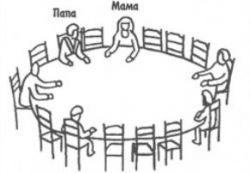
Rene Gilles technique - processing of results
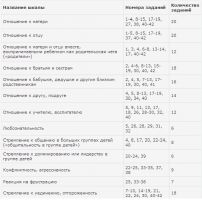
To interpret Rene Gilles’ technique, you should refer to the table. There are 13 variables marked there, each of which is a separate scale. Each of the 13 variables forms an independent scale. The table shows all the scales and also presents the numbers of tasks that characterize one or another area of the child’s life.
Processing the Rene Gilles technique is quite simple. If the child indicates that he sits next to his mother at the table, you need to put a tick on the scale of attitude towards the mother, but if he chooses one of the other relatives, then the tick is placed in front of him accordingly. As for his friends and circle of interests, the interpretation here is similar. As a result, you need to compare the number of questions and the number of checkmarks on the answer form and, based on this, evaluate this or that property of the child.

